From coast to coast, up rivers and on lakes, we're shining the spotlight on these cherished beacons across Corcoran's regions.
Human civilization has long relied on the lighthouse. The Pharos of Alexandria, constructed in Ptolemaic-era Ancient Egypt during the 3rd century BCE, was history’s first. Considered one of the Seven Wonders of the Ancient World, it towered some 330 feet. In Spain, the Tower of Hercules, which dates to the 1st century CE rule of Roman emperor Trajan, still stands as the world’s oldest.
Here in the United States, the need for lighthouses escalated at the turn of the 18th century, driven by increased transatlantic commerce between Great Britain and its colonies. By 1716, the Boston Light lit up that city’s harbor as the first lighthouse on this side of the pond. So vital were these aids to navigation that the inaugural public works program of the 1st United States Congress in 1789 was the Lighthouse Act, which created an agency to manage existing lighthouses and establish new ones.
For a century and a half, federally-employed lighthouse keepers and their families were a fixture in coastal communities, often planting and farming the surrounding lands. Other keepers, namely those in offshore beacons, led a more solitary life with little socialization beyond visits from the lighthouse tender for fuel, mail, and supplies.
On July 1st, 1939, President Franklin D. Roosevelt folded the storied Bureau of Lighthouses under the U.S. Coast Guard, which had little interest in nostalgia. Over the coming years, it reassigned civilian keepers, automated lights, and demolished towers. In 1948, the Coast Guard intentionally set ablaze and toppled the Ponquogue Lighthouse in Hampton Bays, Long Island — one of the country’s tallest — helping stoke public outcry to preserve these coastal landmarks for posterity.
While they’ve long outlived their original purpose, there’s just something about lighthouses that inspires wonder in all of us. Here are some of our favorites to visit across Corcoran’s regions.

Sandy Hook
Sandy Hook Light is a true New Jersey original. 1764 marks the year of its inaugural lighting, single-handedly ushering in an era of masonry lighthouses. Towers were henceforth primarily built from bricks and stones rather than ultra-flammable wood — a recipe for disaster considering early lighthouse optics, or light sources, were often candles. But while being the country’s first masonry lighthouse is pretty neat, the following is even more adulation-worthy: Over hundreds of years and almost as many Bruce Springsteen albums, the Sandy Hook Light remains in its same Monmouth County location, lighting the way for ships. Where many contemporaries have been forced into retirement by modern technologies and exorbitant maintenance costs, the Sandy Hook Light is still putting in work. That makes it the United States’ oldest operating lighthouse, with over 250 years of service. May we all be so lucky to spend even a quarter of that time doing something we love — or, in the lighthouse’s case, something we were explicitly built for.
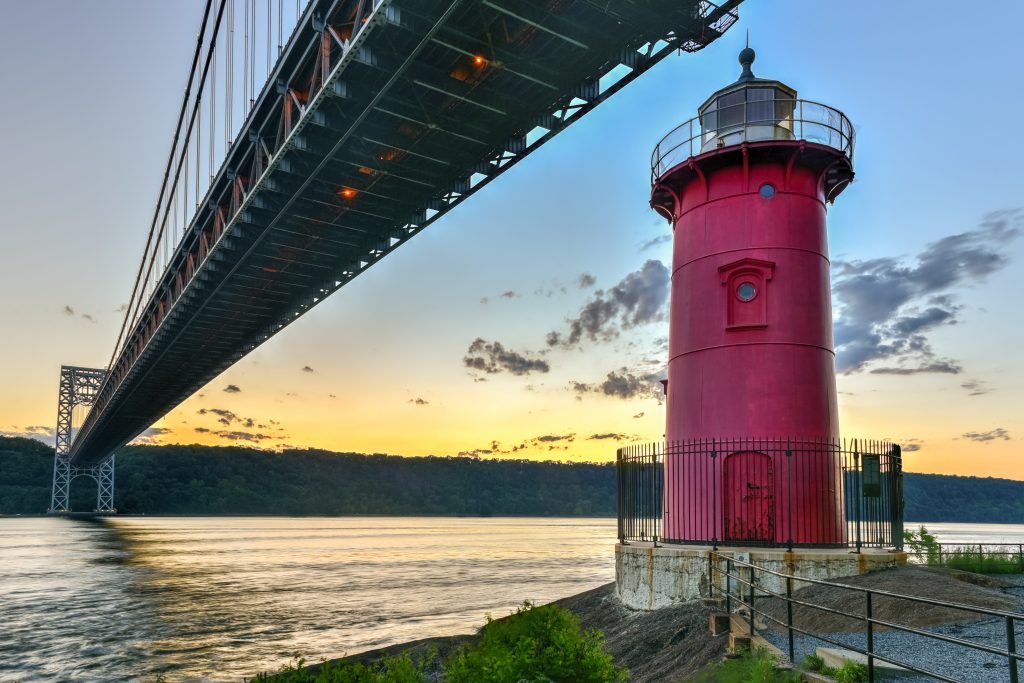
Jeffrey's Hook (Little Red)
You could probably guess the physical appearance of New York City’s Little Red Lighthouse from the name. Despite the George Washington Bridge utterly dwarfing it, Little Red’s unmistakable coloring catches your eye against the gray bridge and surrounding landscape in a way that makes you go, “Wait a minute, is that a tiny lighthouse down there?” Upon exploring Fort Washington Park in Washington Heights, closer inspection will reveal, yes, that is a tiny lighthouse down there; a sort of whimsical treat for city explorers looking for a side of the metropolis a little less metropolitan. Little Red’s operational past is one of perseverance — having been rendered obsolete, dismantled, reassembled in its current location, made obsolete by the GW Bridge, decommissioned, and ultimately extinguished in 1948 — with public outcry stemming from the popular children’s book The Little Red Lighthouse and the Great Gray Bridge ultimately saving the lighthouse and paving the way for its designation as a Historic Place in 1979.
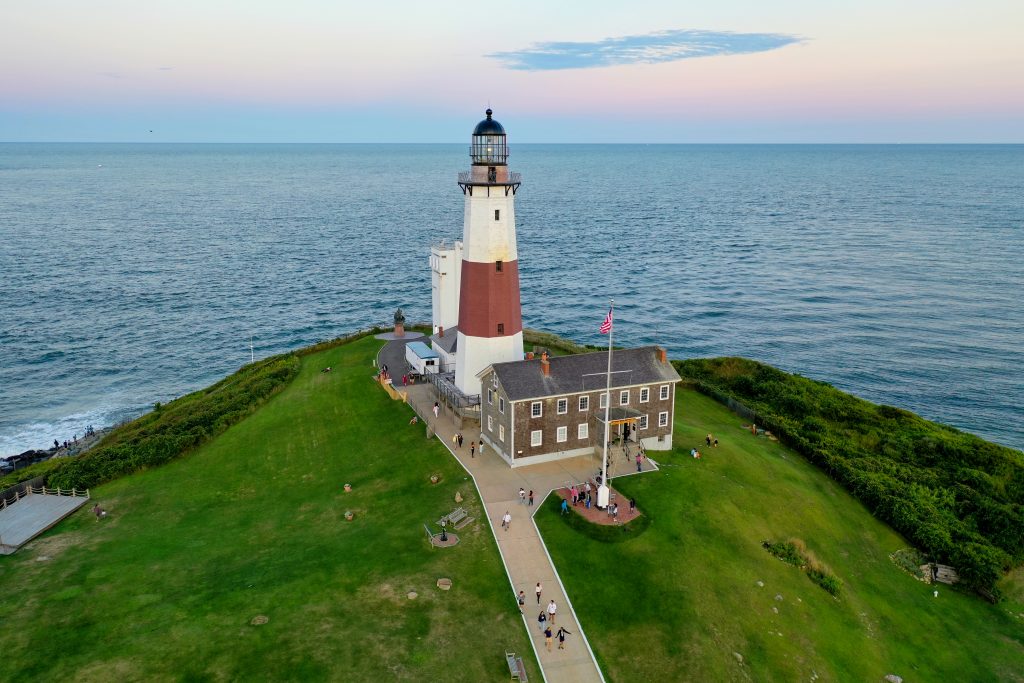
Montauk Point
Undoubtedly, Montauk Point Light is the most significant lighthouse across Long Island. With apologies to the rest, you have to give it up for something when it’s so old that George Washington himself personally authorized its creation. Montauk Point Light was actually the first public works structure built by this nascent nation, also making it the oldest lighthouse in New York from its perch at the East End’s end in Montauk. Furthering the age-related plaudits, though the historic Fresnel lens was replaced with an automated light, the thing still functions, making it the fourth-oldest working lighthouse in the U.S. Then there’s the folklore, like the longstanding rumors of hidden treasure left at the foot of the hill by Captain William Kidd before his arrest for alleged piracy in 1699. While it’s unlikely you’ll uncover his buried bounty, you can explore the lighthouse’s museum, learn more about its story, and ascend the 110-foot tower for 360-degree views across the Atlantic Ocean and Block Island Sound.
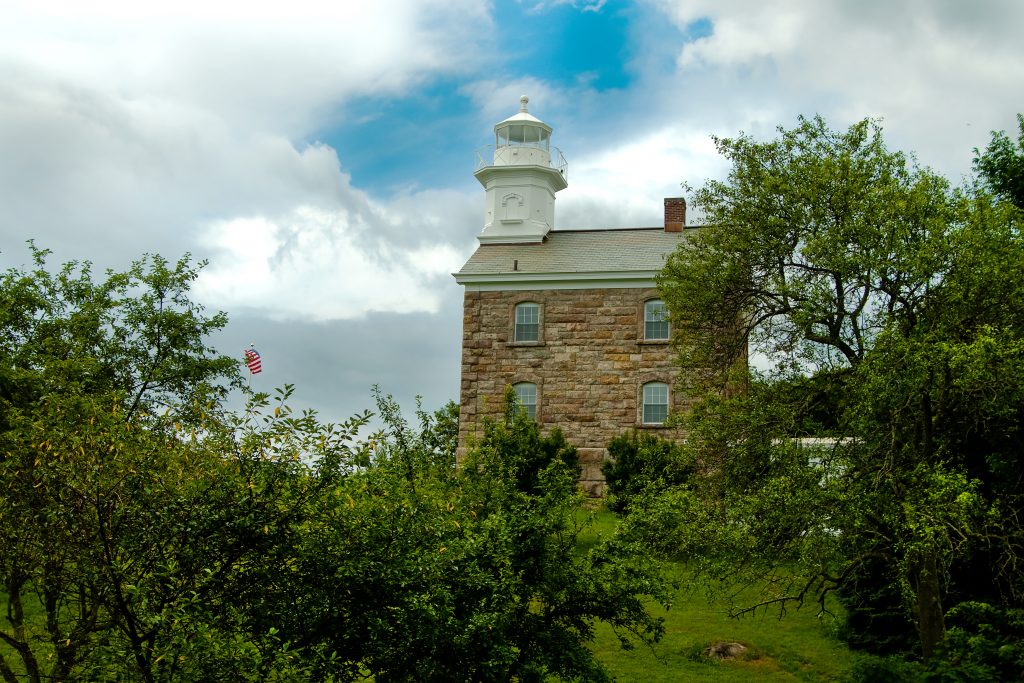
Great Captain Island
Great Captain Island marks New England’s southernmost point, attracts multitudinous nesting birds, and forms a cluster with two isles that sound like its son and grandson: Little Captain and Wee Captain. Ledges, shoals, and other hazards abound in this corridor, making a lighthouse’s presence critical. However, including the Great Captain Island Light here is kind of cheating. Yes, the historic structure served nautical navigators well from its hill above the Long Island Sound off the Greenwich coast. It’s just that this Great Captain Island Light isn’t really the Great Captain Island Light anymore: In 1970, after over 100 years of service, the lighthouse’s beacon was removed from its cast iron lantern and relocated to a skeletal tower nearer to shore. The lighthouse had fallen into disrepair, and the cracks had literally begun to show. Graceful preservation work during the 2000s restored its former glory, and the lighthouse shines today with an ornamental lamp.

Tarrytown
The Headless Horseman isn’t the only thing waiting in the Sleepy Hollow fog. Tarrytown Light is a prototypical caisson lighthouse, the only one left on the Hudson River. Caissons supplanted screw-pile lighthouses — an innovation akin to an octagonal house on stilts designed for warning of hazards further out in the sea — when the latter proved highly susceptible to weather damage. (Other classic examples of caisson designs are found in Orient Point and Rowayton). Upon Tarrytown Light’s completion in 1883, its 60-foot conical cast iron tower rose from a stone-surrounded cast iron base with a four-story keeper’s quarter inside. Even though finding furniture to fit into the round rooms proved challenging, keepers lived a charmed life from inside Tarrytown Light. Typically, life in a home in the middle of the water was lonely, but Tarrytown Light was so close to shore and the tantalizing twin towns of Tarrytown and Sleepy Hollow that keepers loved the assignment — there were just 12 of them, through 78 years of crewed operation.
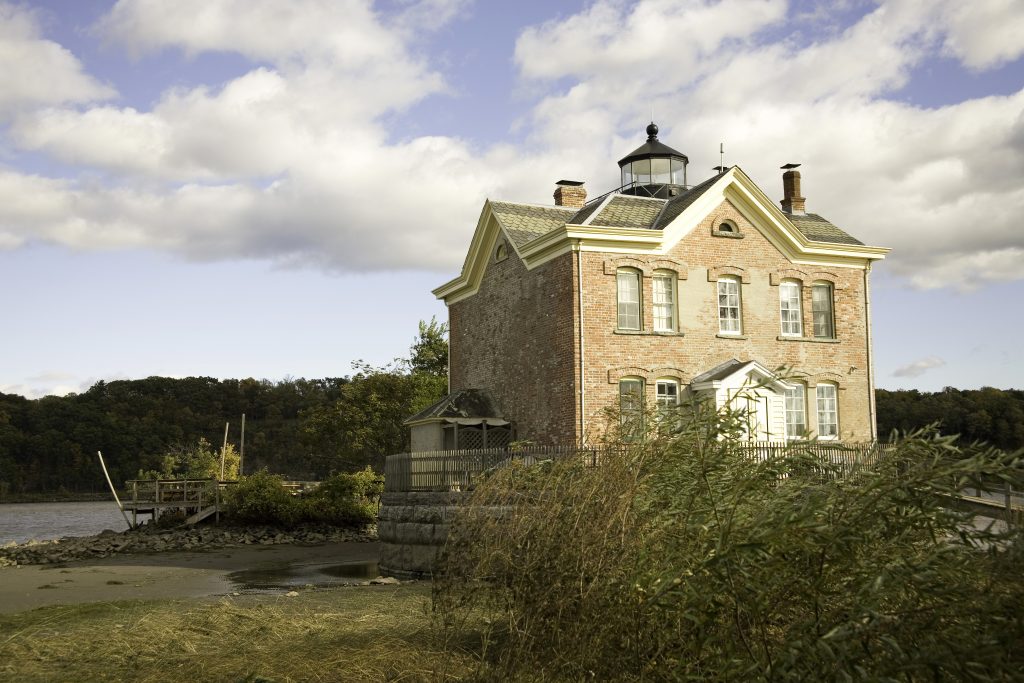
Saugerties
What if a lighthouse was just a regular house? Essentially a charming waterfront residence with sweeping views and a relatively small beacon, Saugerties Lighthouse, in New York’s Hudson Valley, has endured largely for being just that. Erected in 1867, the brick structure is physically less light and more house, though it’s certainly a soothing nightlight for folks who make their home across the the river in Tivoli and its surrounding communities. A long history of keepers includes sisters Kate and Ellen Crowley, whose heroics in saving folks were well-renowned in the 19th century. Things fell into swift disrepair after the signal’s 1954 automation, but intervention by Saugerties locals held off the dreaded Coast Guard wrecking ball. The entire building was painstakingly restored, and though everything remains automated these days, the lighthouse is once again occupied: Anyone can stay in the Saugerties Lighthouse’s charming bed and breakfast, complete with a coal stove and nature trail access along Esopus Creek.

Makapu’u Point
Let’s talk about lenses. In a lighthouse, the lens sits in the lantern atop the tower and is what magnifies the optic. Fresnel lenses have been the go-to technology since their invention in the early 1820s, widely adopted because of a thinner structure that focused and projected light miles further than before. Sizes vary depending on need but typically operate on a scale from sixth-order (slightly under 1.5 feet tall) to first-order (nearly 8.5 feet tall). Oahu’s Makapu’u Point Lighthouse is a bit atypical in this sense, as its Fresnel is literally off the chart. Illuminating above Oahu’s easternmost point, the 12-foot-tall hyper-radial lens is the country’s largest. When Makapu’u went automated in 1974, keepers were no longer needed to manage that behemoth. However, their quarters proved valuable in secretly housing key witnesses during a Hawaiian crime boss’ high-profile tax- evasion trial. Turns out, the gigantic signal literally giving away its location is the last place people think to look.
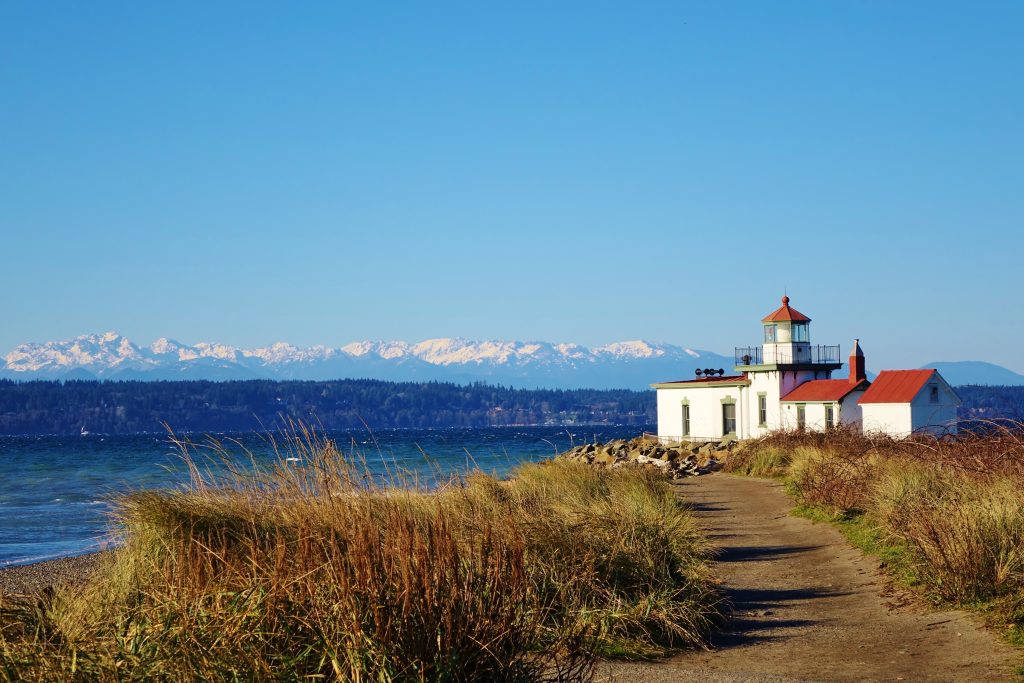
West Point
Red-and-white is an oft-recurring motif for lighthouse paint jobs across the country. It’s no different in Washington, where the beacons often meld with various humble one-story structures — typically offices or fog signals — to resemble a miniature house-fort. It’s the case at the westernmost point in Seattle, where the very aptly-named West Point Lighthouse lives. West Point falls within 534-acre Discovery Park, Seattle’s most extensive public green space. This location makes the lighthouse a landmark for visitors, whether birding after the park’s 270-plus avian species, hiking a 4.4-mile loop trail, relaxing on the sands of the Puget Sound, or staring off toward the Olympic mountains. The West Point Lighthouse was the first manned one built on the Puget Sound in 1881, and it still guides ships today. Light flashes from the stuccoed brick tower every five seconds, alternating between red and white. Just like the favored lighthouse uniform.
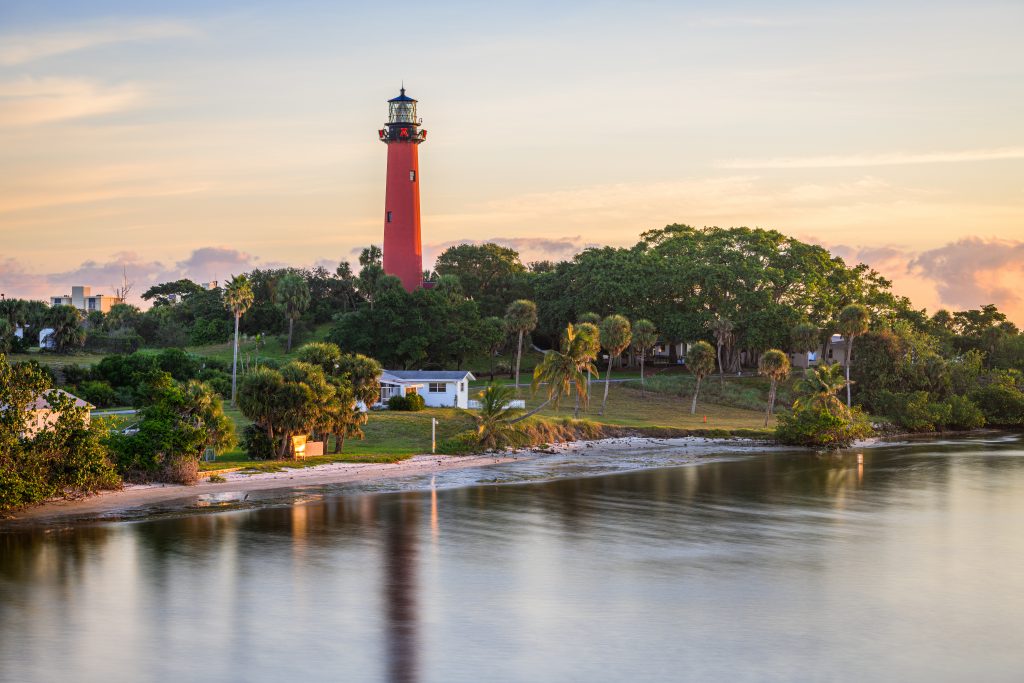
Jupiter Inlet
Belying its location in serene Jupiter, Florida, the Jupiter Inlet Light has a history of courting drama. From construction authorization to completion, seven years elapsed. Storms clogged up the lighthouse’s eponymous waterway, and the Third Seminole War took away its work crew almost as soon as they arrived. Less than a year after the lighthouse’s eventual, long-delayed 1860 lighting, the Civil War’s outbreak would keep it dark again until 1866. During World War II, the U.S. Navy converted part of the greater reservation the lighthouse resides on into “Station J,” a secret radio installation that intercepted German U-boat messages. Yet, the Jupiter Inlet Light has emerged from it all stronger than ever. Maybe that’s because it has thick double brick walls that keep everything fortified and stalwart, but who’s to say? Either way, there’s no mistaking that distinct red coat of paint (a cover-up for humidity-induced discoloration — like we said, drama) of the Jupiter Inlet Light soaring over 150 feet above the Loxahatchee River.
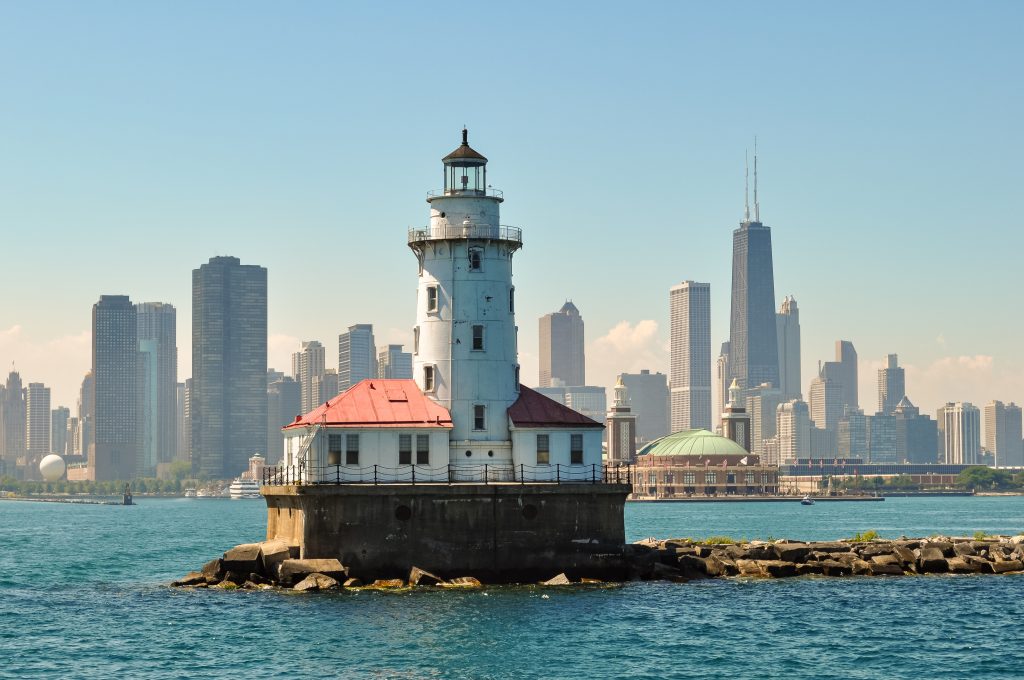
Chicago Harbor
Wedged between a fog signal and a boathouse, the brick and cast iron Chicago Harbor Lighthouse is a sea-salted sandwich served on a plate of Lake Michigan breakwater. Chicago’s history with lighthouses closely follows its advancement as a vital port. Burgeoning commerce in the expanding metropolis necessitated harbors, piers, and breakwaters, all requiring signal lights further and further asea. All told, Chicago Harbor Lighthouse is the third beacon (fourth if you count one that collapsed after seven months in 1831) to illuminate Chicago’s shores, and even it moved locations in 1919. It was first completed in 1893 and crowned with a third-order Fresnel lens displayed that same year at the Chicago world’s fair. San Diego’s New Point Loma Lighthouse had been the intended recipient of that lens, a gold medal winner at the 1889 Paris world’s fair. But, the quite convenient coincidence of Chicago Harbor’s completion coinciding with the 1893 exhibition kept the lens in the Windy City.
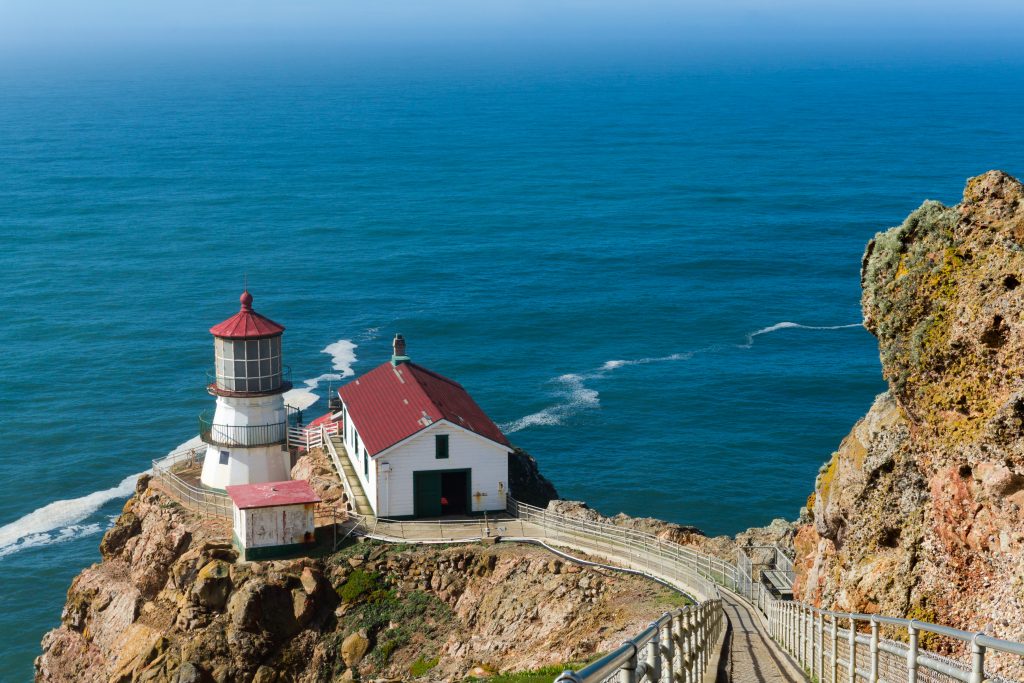
Point Reyes
Northern California has a legion of lighthouses that are plenty historic, eminently eye-catching, or, in most cases, both. The Point Reyes lighthouse, however, is those things and more: It’s certifiably cinematic. For his 1980 film The Fog, John Carpenter utilized the distinct cliffside beacon to help set the cult classic’s unsettling seaside atmosphere. Seeing those distinct red roofs and the bulbous tower lantern with its first-order Fresnel lens adds that authentic extra touch needed when the driving plot force is a mysterious fog sweeping across town and bringing vengeful ghost sailors with it. No fog-encased ghost sailors that we know of have actually docked off the shores of Marin County. Nevertheless, years of evidence genuinely document the area surrounding the lighthouse’s cliffside as the Pacific Coast’s foggiest and windiest locale. Shipwrecks were far too common — there were 14 over the 15 years a land dispute held up construction — necessitating this signal, now iconic among pharology (the study of lighthouses) buffs and horror fans alike.
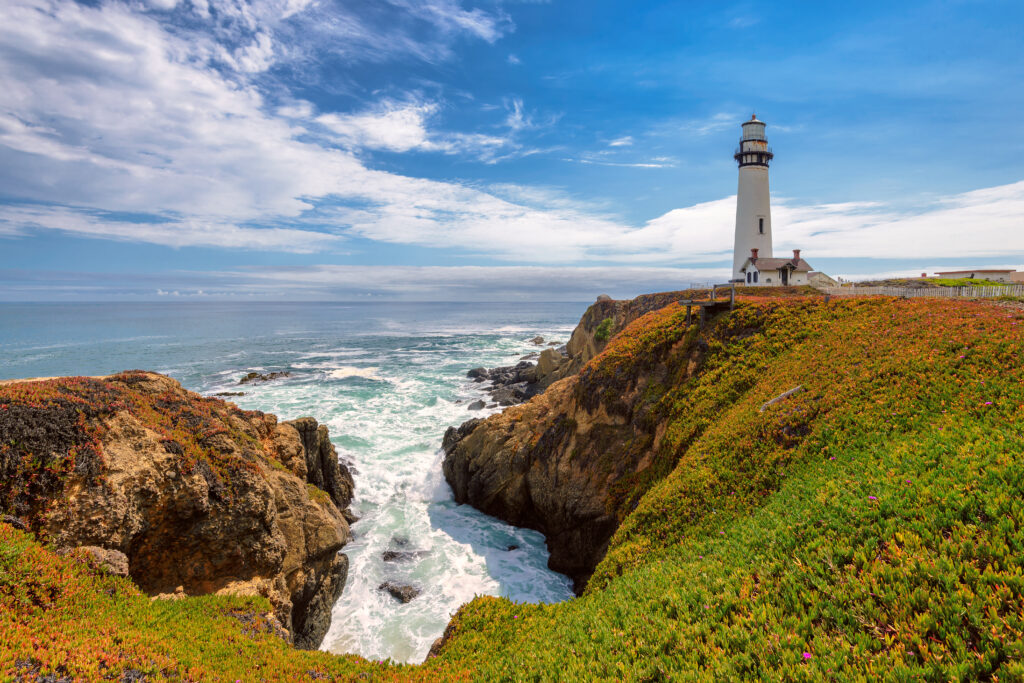
Pigeon Point
One fateful day in 1853, the captain of the clipper ship “Carrier Pigeon” — dazed by that dense fog the Bay Area is famous for — miscalculated his distance from shore, running the vessel into the rocks. And his destination was so close, too, after sailing all the way from Boston via Cape Horn in Tierra del Fuego. In his defense, there was no light. The incident, however, sparked the push for a beacon on the promontory previously called Punta de las Ballenas (Spanish for “Point of the Whales”), which would come to be known as Pigeon Point.
What we got looks much more New England than Coastal California, a detail hard to miss considering the tower is 115 feet high — tied with Point Arena for the West Coast’s tallest lighthouse. Its rotating first-order Fresnel lens shone at last in 1872, relocated cross-country from atop the original Cape Hatteras light. That lens was deactivated a century later, but the historic white masonry station remains an active, automated aid.
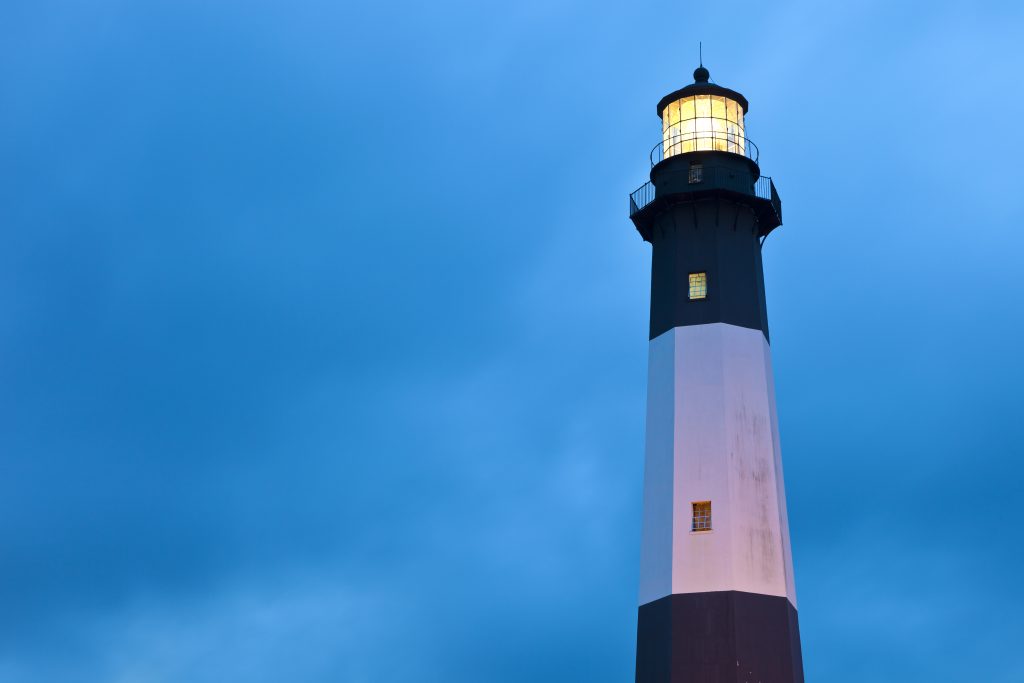
Tybee Island
Georgia may not immediately come to mind when you think of lighthouses, but the Peach State is home to seven currently-standing coastal beacons. Around Savannah, you’ll spot the alternating black-and-white-clad Tybee Island Light. Altogether, the light station at Tybee Island is the oldest in the American South and the second-oldest in the nation, dating to 1736. But if we’re getting granular about it, this lighthouse is the fourth tower to reside on Tybee Island. The first two — which were unilluminated daymarks, not lighthouses — were done in by a storm and shoreline erosion, respectively. Version three lit up in more ways than one, outfitted with a second-order Fresnel lens before Confederate forces burned the tower and took the lens while abandoning the outpost.
Today’s Tybee Island Light has also endured its struggles, withstanding an 1871 hurricane and a rare 1886 earthquake. Thanks to preservation efforts, the lighthouse is restored, shines daily, and serves as a museum.

Sullivan’s Island
For many reasons, you cannot miss the Sullivan’s Island Lighthouse outside Charleston. In a historical sense, its 1962 completion represents the last major lighthouse project undertaken by the government. Physically speaking, how does one not see a 140-foot black-and-white triangle shooting up into the sky? Sullivan’s Island owes its idiosyncratic shape to designer Jack Graham, who trained under legendary architect Louis Kahn. The pointy end of the aluminum-enclosed concrete-and-steel structure faces the ocean, allowing it to withstand 125-mile-per-hour winds. Graham also insisted on an elevator, making this the only lighthouse in the country with such a convenience. Then there’s the matter of the lighthouse’s actual light, initially so intense at 28-million candlepower units that keepers needed asbestos welding suits to enter the lantern room. If you’re curious how powerful that really is, consider that even after being dimmed to a modest 1.2-million candlepower beam, Sullivan’s Island Lighthouse remains the brightest in the United States, visible for 26 nautical miles.
